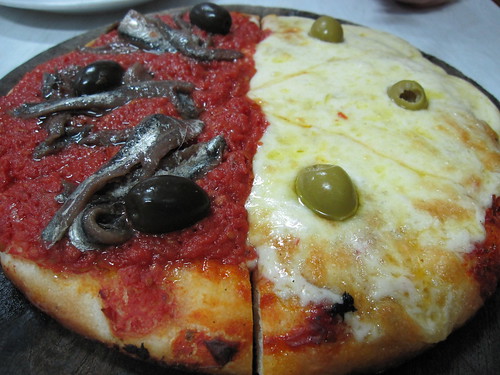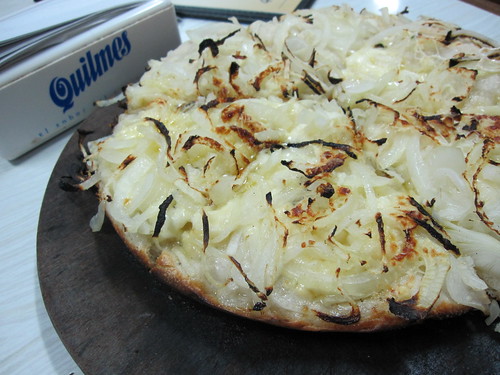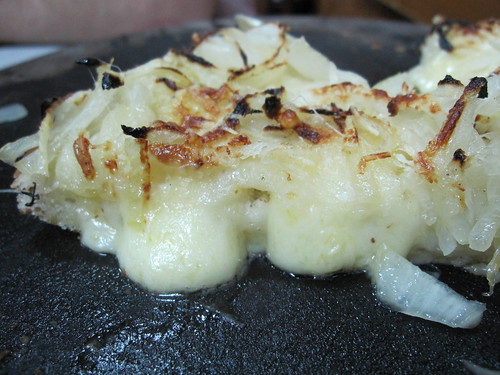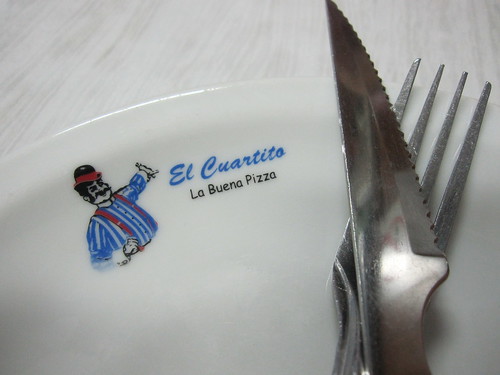It’s fairly safe to say that no group, with the exception of the enigmatic gaucho, played as significant a role in defining Argentine national character as the Italians. Primarily (and principally, numerically-speaking) from Liguria (particularly Genoa), Piemonte and Tuscany, but latterly also from Naples and other areas of southern Italy, these Italian immigrants, literally by the million, descended on Argentine soil during the last decades of the 19th century and the inter-war period of the 20th century having a profound effect on the social, cultural, linguistic and gastronomic life of their adopted home. (bear with me, this is going somewhere)
And nowhere in Argentina was this impact greater than in the southern barrios of Buenos Aires, La Boca and San Telmo, the neighborhoods where these Italians began their new lives. A (then) new local slang, lunfardo - which not only features a highly confusing form of wordplay known as vesre that reverses words so tango becomes gotan (as in The Gotan Project) and cafe con leche becomes feca con chele, but which is also littered liberally with words taken from various Italian dialects (for example, laburar (to work) instead of trabajar, manyar (to eat) instead of comer) – grew out of this linguistic melting-pot. And it had a similar effect of Italicizing the Porteño diet with such Italian staples as pizza, pasta, gnocchi, and a variety of Genoese chickpea flatbread known locally as faína (similar to the famous farinata of Genoa we wrote about a while back) accompanying the ubiquitous steak and offal on restaurant menus.
Of course, (and paraphrasing Karl Marx) the Argetin-izing of these Italian staples was also just as much of a historical inevitability, and while we’ll revisit our experiences with Argentine pasta in a later post, the focus here is Argentine pizza, and in particular the Buenos Aires classic dish that is the fugazzetta.
More or less three “types” of pizza are available in Buenos Aires: thin crust (a la piedra), a thicker, more risen (1 inch/2cm thick) doughy kind known as de molde, and media masa which is a half-baked version sold in supermarkets to be finished off in the oven at home. An informal and in no way scientific survey by yours truly indicates that a la piedra places slightly outnumber those selling thicker pies, but many of the most traditional Argentine pizzerias we read about, served pizzas in the latter camp, so it was one of the most famous of these that we endured a sweaty, grimy, two-hour walk across town to visit.
El Cuartito is decorated like the bedroom of an aging (and single) sports fan with faded posters for Las Vegas boxing showdowns cheek-by-jowl with team photos of 1980s Argentine soccer champions sporting the shiny, shortie-shorts popular at the time, and is split into two sections: standing and seated. Claiming a table in the seated section, the gruff, white-jacketed waiter – a dead-ringer for Fredo Corleone from The Godfather – plonked down two menus on our formica-topped table and scurried off.
Glancing at our fellow diners it quickly became apparent that Argentine de molde-style pizza is very different from any pizza we had ever eaten. Laden with masses of yellowy-white melted cheese, dotted sparingly with other toppings (like whole green olives and big slices of tomato) and served on circular wooden boards, it didn’t resemble either the pizza we’ve eaten in Italy or in New York or Chicago. Excited at having entered a new realm of pizza-dom, we ordered a pizza mixta (half cheese, half anchovy (no cheese, only red sauce on anchovy side), a fugazzetta, and an order of faína, along with two foamy mugs of Quilmes Chopp (ubiquitous draft Argentine beer).
The first to arrive, the mixta, was about the diameter of a large dinner plate and a shade less than an inch in depth. Half-covered with molten cheese (that tasted like somewhere between a mozzarella and a mild provolone) with the opposing half smothered in a crimson tomato sauce and laced with some giant salted anchovies, it would have been a good lunch by itself, and we were happy, when the fugazzetta hove into view, that “Fredo” our waiter ended up forgetting about the faína.
Now, remember the seemingly dull linguistic and ethnographic details in the second paragraph? Good, because the word fugazetta is derived from “fugassa” meaning “focaccia” in Genoese dialect, and is the name given in Argentina to an onion focaccia with grated cheese gratiné-ed on top. First created by Genoese immigrant baker Agustin Banchero in La Boca around the turn of the 20th-century, the fugazza has since become famous enough that the family have not only opened a series of Banchero Pizzerias (first one in 1932), but the recipe was so valuable it was patented in the 1950s.
So, then, if a fugazza is a thick onion pizza, a fugazzetta – purportedly invented by Agustin’s son, Juan – is a fugazza stuffed with mozzarella cheese. And, when one arrives on your table with a solid thunk, you realize that this is a serious deal and rightly famous. Our faces were a mixture of surprise, delight and fear when we were presented with ours. Puffed up like a yeasty Michelin man, our fugazzetta was probably three inches thick, oozing with melted cheese and bristling with crispy sweet onions.
Deciding that we should take a brief rest before hurting ourselves on the fugazzetta, we searched for inspiration in the boxing posters on the walls and began humming the Rocky theme tune quietly to ourselves. Immediately to our left, was a framed Argentina soccer jersey, with the phrase “a mi favorito El Cuartito, siempre a mi cariño” (to my favorite “El Cuartito”, always in my heart), signed by one of, if not the, greatest soccer (futbol) players of all time, Argentine icon, Diego Armando Maradona, aka “El Pibe de Oro” (the golden kid).
Now, this was significant not just because a shirt signed by the great man loomed above us like Rio’s Christ the Redeemer statue, but also because, in the context of the giant fugazzetta slumping threateningly before us and our knowledge of recent Argentine history, it appeared more like the Argentine shroud of Turin. You see, (it’s not clear when Maradona signed this jersey), but in early 2005 Diego had to be admitted to hospital to have his stomach-pumped after eating an estimated 25 pizzas during a food and cocaine binge that nearly killed him. If the jersey was inked after this misadventure, one can only deduce that the pizza at El Cuartito is so good it’s impossible to bear a grudge against.
So, chastened by this story of gluttonous daring, but undeterred, we managed to get about halfway through the cheesy, crispy, doughy fugazzetta before conceding a weary, yet happy, defeat. To our right, two Porteños sporting significant bellies, were noisily tucking in to a fugazzetta of their own but, amazingly, were topping it with thick slabs of faína. As we waddled towards the door, it suddenly hit us that we had a lot to learn about the lore of Argentine pizza-eating if we were ever going to be able to compete with the locals, let alone the legends.
Special thanks to La Cocina de Myri for her excellent history of the Fugazzetta I cribbed from liberally above.
Talcahuano 937, San Nicolás
Buenos Aires, Argentina
T: 54-11-4816-1758
Meals: US$10-15, AR$40-60



























